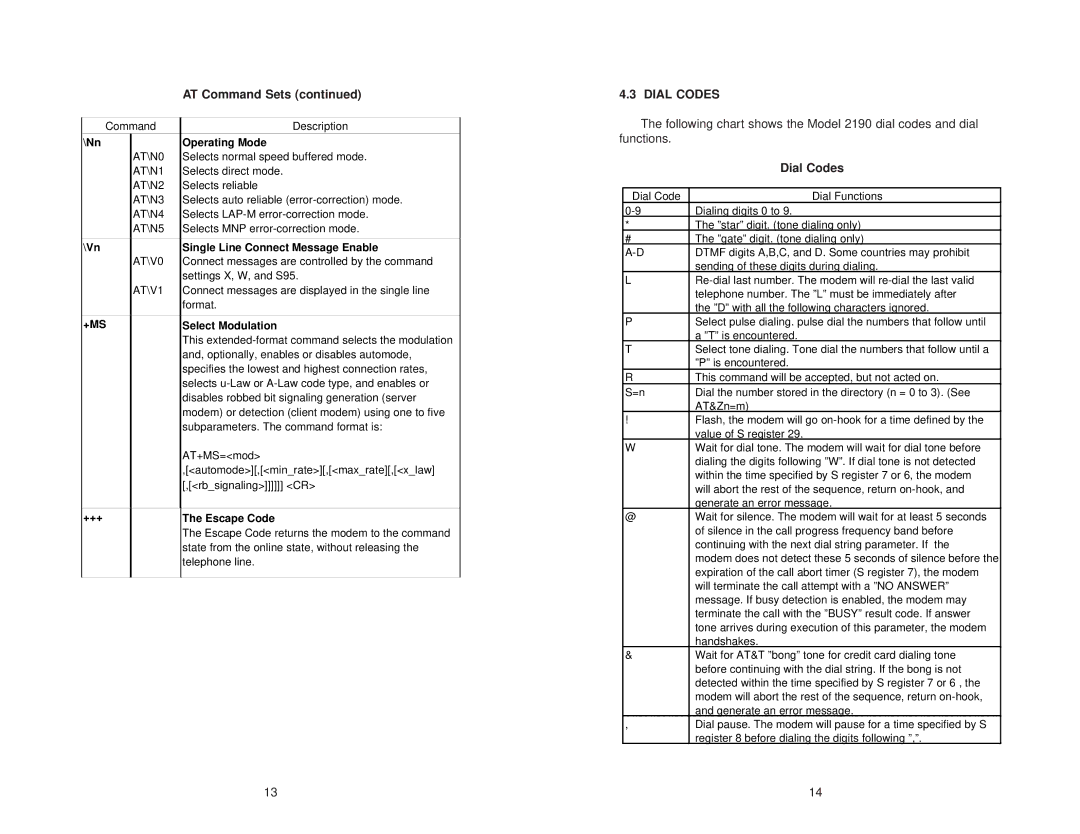|
| AT Command Sets (continued) |
|
| |
Command | Description | |
\Nn |
| Operating Mode |
| AT\N0 | Selects normal speed buffered mode. |
| AT\N1 | Selects direct mode. |
| AT\N2 | Selects reliable |
| AT\N3 | Selects auto reliable |
| AT\N4 | Selects |
| AT\N5 | Selects MNP |
|
|
|
\Vn |
| Single Line Connect Message Enable |
| AT\V0 | Connect messages are controlled by the command |
|
| settings X, W, and S95. |
| AT\V1 | Connect messages are displayed in the single line |
|
| format. |
|
|
|
+MS |
| Select Modulation |
|
| This |
|
| and, optionally, enables or disables automode, |
|
| specifies the lowest and highest connection rates, |
|
| selects |
|
| disables robbed bit signaling generation (server |
|
| modem) or detection (client modem) using one to five |
|
| subparameters. The command format is: |
|
| AT+MS=<mod> |
|
| ,[<automode>][,[<min_rate>][,[<max_rate][,[<x_law] |
|
| [,[<rb_signaling>]]]]]] <CR> |
|
|
|
+++ |
| The Escape Code |
|
| The Escape Code returns the modem to the command |
|
| state from the online state, without releasing the |
|
| telephone line. |
|
|
|
4.3 DIAL CODES
The following chart shows the Model 2190 dial codes and dial functions.
| Dial Codes |
|
|
Dial Code | Dial Functions |
Dialing digits 0 to 9. | |
* | The ”star” digit. (tone dialing only) |
# | The ”gate” digit. (tone dialing only) |
DTMF digits A,B,C, and D. Some countries may prohibit | |
| sending of these digits during dialing. |
L | |
| telephone number. The ”L” must be immediately after |
| the ”D” with all the following characters ignored. |
P | Select pulse dialing. pulse dial the numbers that follow until |
| a ”T” is encountered. |
T | Select tone dialing. Tone dial the numbers that follow until a |
| ”P” is encountered. |
R | This command will be accepted, but not acted on. |
S=n | Dial the number stored in the directory (n = 0 to 3). (See |
| AT&Zn=m) |
! | Flash, the modem will go |
| value of S register 29. |
W | Wait for dial tone. The modem will wait for dial tone before |
| dialing the digits following ”W”. If dial tone is not detected |
| within the time specified by S register 7 or 6, the modem |
| will abort the rest of the sequence, return |
| generate an error message. |
@ | Wait for silence. The modem will wait for at least 5 seconds |
| of silence in the call progress frequency band before |
| continuing with the next dial string parameter. If the |
| modem does not detect these 5 seconds of silence before the |
| expiration of the call abort timer (S register 7), the modem |
| will terminate the call attempt with a ”NO ANSWER” |
| message. If busy detection is enabled, the modem may |
| terminate the call with the ”BUSY” result code. If answer |
| tone arrives during execution of this parameter, the modem |
| handshakes. |
& | Wait for AT&T ”bong” tone for credit card dialing tone |
| before continuing with the dial string. If the bong is not |
| detected within the time specified by S register 7 or 6 , the |
| modem will abort the rest of the sequence, return |
| and generate an error message. |
, | Dial pause. The modem will pause for a time specified by S |
| register 8 before dialing the digits following ”,”. |
13 | 14 |
